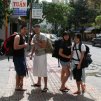Busy border guards show tourists the way
Aside from their duties protecting Viet Nam's borders and nearby inhabitants, soldiers at A Pa Chai border station have acquired another role: leading tourists on trips to the country's furthest outpost.
Viet Nam's border guards have an extremely important responsibility. They are the men and women who protect the nation's territorial sovereignty and the people living on the furthermost edges of the country.
The soldiers at the A Pa Chai border station in the western province of Dien Bien have another duty, and it is one that they perform with equal devotion. It is their responsibility to lead tourists to the border marker which falls under their jurisdiction. This is Border Marker Zero, and it stands at the point which separates Viet Nam, Laos and China.
I recently visited this famous spot with a group of friends for the very first time. The experience left us all with a deep impression of pride and awe.
To reach the border checkpoint we travelled nearly 300km from the city of Dien Bien and prepared to tackle the Khoan La San mountain top, which reaches 1,866m. At the peak stands the famous three-faced border marker, where it is possible to place two feet in two different countries at the same time. It is often remarked that in this spot, "when a cock crows, three countries hear".
Before we began our climb, we met Captain Hoang Kim Thanh at A Pa Chai station and he filled us in on the history of the border. His team is responsible for managing an 18km stretch bordering with China and 18km bordering with Laos.
"We also watch over the Sin Thau Commune of Muong Nhe District, which is made up of six villages belonging to the Ha Nhi ethnic people. Our main task that is to patrol and protect the border, but we also work hard to accommodate tourists and trekkers who want to visit the border marker. We consider this to be one of our political tasks," he told us.
In recent years, thousands of tourists have arrived in A Pa Chai. Visiting groups are often offered food and shelter at the border station for convenience before they depart for their sightseeing.
Sometimes, such as during the recent Lunar New Year celebrations, the site is inundated with tourists and overcrowding means that all officers and soldiers at the station must give up their beds and share their meals with the visitors.
Captain Thanh said that his wife came to visit him with their two children last year. To let his family understand his role, he took them to visit the marker. He helped his children, aged 10 and 4, to the pinnacle of Khoan La San, where they became the youngest citizens ever to visit the site.
Our ascent
For our own climb to the mountain top, we were accompanied by 23-year-old First Class Private Luong Van Pang, who helped carry our bags and show us the way.
He skipped up the slope, whistling cheerfully without ever seeming to lose breath, while we struggled on behind, huffing and puffing and calling for regular breaks. After more than two hours we stopped next to a stream and breathlessly asked how far we had come. "We're about halfway," replied a grinning Pang.
After more than four hours of struggle, we finally reached our destination. Luckily, the effort was well worth it.
The marker itself, while only built in 2005, exudes gravitas and a sense of history. It is a marble boulder, two metres tall and carved into a triangular shape, its three sides looking down on a different country. Each side of the marker is engraved with the relevant national flag and name.
Around the stone is a clear, spacious circle which can hold up to a dozen tourists at a time. When we visited, we shared the spot with a group from Ha Noi and a party from China, who had climbed up from the other side of the mountain. Stood together in this unique spot, we felt a bond between us and spoke like old friends.
Our group retrieved some Vietnamese flags and we posed for pictures on the Viet Nam side. Afterwards, two border guards demonstrated a military ritual saluting the marker, which we then performed.
One of the Hanoians, Pham Tien, said, "Stood here I feel very satisfied and proud. I've been to several far flung border areas in the country, such as Lung Cu in Ha Giang and Mong Cai in Quang Ninh Province, and now today I have arrived at the furthest point west, so I am happy. Visiting has also allowed us to realise that Viet Nam is very large, but our border sovereignty is still strongly maintained."
Pang told us that his busy schedule meant that he did not often get the opportunity to lead visitors to the border.
"My comrade Ngo Van Nghi usually takes on the role of guide. He once helped a 72-year-old man who insisted on climbing up to the marker. When coming back he was too tired to continue, so Nghi and some others had to carry him on their backs. There have been other times when my colleagues have had to make temporary tents for tourists when they get caught in heavy storms. A journey leading people to the top and back can taker a whole day, but nobody complains, as we consider it our task."
With the popularity of the trek growing all the time, it is thanks to officers like Nghi and Pang that citizens can experience the country's spirit and togetherness for themselves at this border post on the very edge of their beloved Viet Nam.
Find your tours
with us ?


